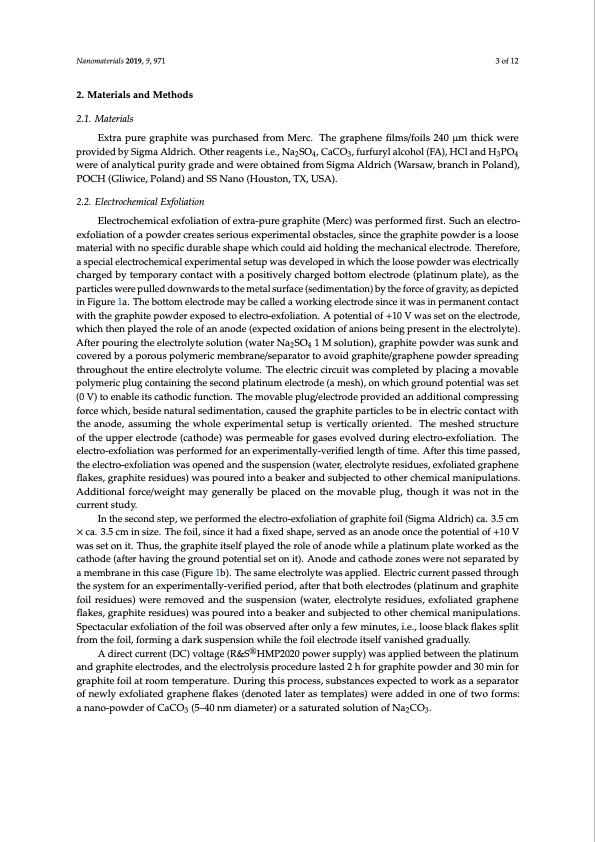
PDF Publication Title:
Text from PDF Page: 003
Nanomaterials 2019, 9, 971 3 of 12 2. Materials and Methods 2.1. Materials Extra pure graphite was purchased from Merc. The graphene films/foils 240 μm thick were provided by Sigma Aldrich. Other reagents i.e., Na2SO4, CaCO3, furfuryl alcohol (FA), HCl and H3PO4 were of analytical purity grade and were obtained from Sigma Aldrich (Warsaw, branch in Poland), POCH (Gliwice, Poland) and SS Nano (Houston, TX, USA). 2.2. Electrochemical Exfoliation Electrochemical exfoliation of extra-pure graphite (Merc) was performed first. Such an electro- exfoliation of a powder creates serious experimental obstacles, since the graphite powder is a loose material with no specific durable shape which could aid holding the mechanical electrode. Therefore, a special electrochemical experimental setup was developed in which the loose powder was electrically charged by temporary contact with a positively charged bottom electrode (platinum plate), as the particles were pulled downwards to the metal surface (sedimentation) by the force of gravity, as depicted in Figure 1a. The bottom electrode may be called a working electrode since it was in permanent contact with the graphite powder exposed to electro-exfoliation. A potential of +10 V was set on the electrode, which then played the role of an anode (expected oxidation of anions being present in the electrolyte). After pouring the electrolyte solution (water Na2SO4 1 M solution), graphite powder was sunk and covered by a porous polymeric membrane/separator to avoid graphite/graphene powder spreading throughout the entire electrolyte volume. The electric circuit was completed by placing a movable polymeric plug containing the second platinum electrode (a mesh), on which ground potential was set (0 V) to enable its cathodic function. The movable plug/electrode provided an additional compressing force which, beside natural sedimentation, caused the graphite particles to be in electric contact with the anode, assuming the whole experimental setup is vertically oriented. The meshed structure of the upper electrode (cathode) was permeable for gases evolved during electro-exfoliation. The electro-exfoliation was performed for an experimentally-verified length of time. After this time passed, the electro-exfoliation was opened and the suspension (water, electrolyte residues, exfoliated graphene flakes, graphite residues) was poured into a beaker and subjected to other chemical manipulations. Additional force/weight may generally be placed on the movable plug, though it was not in the current study. In the second step, we performed the electro-exfoliation of graphite foil (Sigma Aldrich) ca. 3.5 cm × ca. 3.5 cm in size. The foil, since it had a fixed shape, served as an anode once the potential of +10 V was set on it. Thus, the graphite itself played the role of anode while a platinum plate worked as the cathode (after having the ground potential set on it). Anode and cathode zones were not separated by a membrane in this case (Figure 1b). The same electrolyte was applied. Electric current passed through the system for an experimentally-verified period, after that both electrodes (platinum and graphite foil residues) were removed and the suspension (water, electrolyte residues, exfoliated graphene flakes, graphite residues) was poured into a beaker and subjected to other chemical manipulations. Spectacular exfoliation of the foil was observed after only a few minutes, i.e., loose black flakes split from the foil, forming a dark suspension while the foil electrode itself vanished gradually. A direct current (DC) voltage (R&S®HMP2020 power supply) was applied between the platinum and graphite electrodes, and the electrolysis procedure lasted 2 h for graphite powder and 30 min for graphite foil at room temperature. During this process, substances expected to work as a separator of newly exfoliated graphene flakes (denoted later as templates) were added in one of two forms: a nano-powder of CaCO3 (5–40 nm diameter) or a saturated solution of Na2CO3.PDF Image | Electro-Exfoliation of Graphite to Graphene

PDF Search Title:
Electro-Exfoliation of Graphite to GrapheneOriginal File Name Searched:
graphene-aqueous-salt-al.pdfDIY PDF Search: Google It | Yahoo | Bing
Salgenx Redox Flow Battery Technology: Power up your energy storage game with Salgenx Salt Water Battery. With its advanced technology, the flow battery provides reliable, scalable, and sustainable energy storage for utility-scale projects. Upgrade to a Salgenx flow battery today and take control of your energy future.
| CONTACT TEL: 608-238-6001 Email: greg@infinityturbine.com | RSS | AMP |